 RUS RUS
 ENG ENG
 Atmo Atmo
 Turbo Turbo
 Nitrous oxide Nitrous oxide
 Calc of jet Calc of jet
 Brakes Brakes
 Front Front
 Rear Rear
 Inlet Inlet
 Exhaust Exhaust
 Cylinder head Cylinder head
 Camshaft Camshaft
 Chip tuning Chip tuning
 Clutch Clutch
 Gearbox Gearbox
 Ring & Pinion Ring & Pinion
 Differential Differential
 Calc of ratios Calc of ratios
|
Turbocharged engine.
Turbo or the atmosphere engine, who is faster?
Since then, they started to appear on the first turbine of tuned cars, the question arises - who is the fastest car with a turbocharged or atmosphere engine with large camshafts?
The answer is straightforward - correctly assembled turbo engine does not leave any chance most "evil atmosphere".
The most powerful naturally aspirated engine currently used in Formula 1 race car, with one liter of engine capacity would be about 300 horsepower.
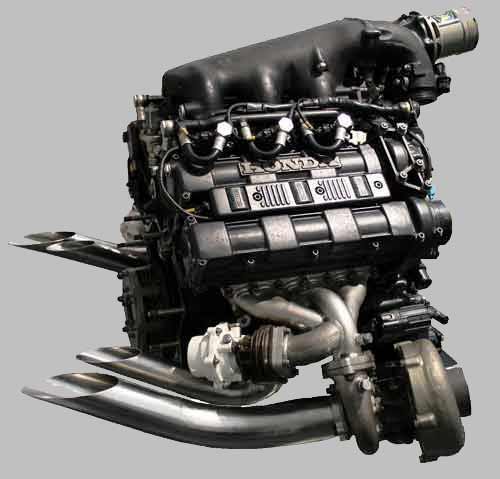 For example: properly assembled turbo motor delivers up to 900 bhp per liter of volume, with a supercharged 5.5 bar. These motors are used in the Formula 1 during the turbo era from 1977 to 1988, one engine of 1.5 liters gave power 700 to 1400 bhp (see photo).
For example: properly assembled turbo motor delivers up to 900 bhp per liter of volume, with a supercharged 5.5 bar. These motors are used in the Formula 1 during the turbo era from 1977 to 1988, one engine of 1.5 liters gave power 700 to 1400 bhp (see photo).
These motors are now used in drag racing class "top fuel" in USA, with engine capacity of 8.2 liters is 7000 bhp.
From where do these horsepower? After all, conventional internal combustion engine is approximately 60 bhp per liter.
Ordinary motor targeted at driving in the urban environment, with torque at low revs. This arrangement has its limits in the maximum power and speed. Cylinders have a huge potential for increased power without increasing volume engine.
How much you can increase engine power by turbines? With increasing pressurization of 1 bar, the power increases by about 100%. That is, if the engine was initially 100 bhp, the turbocharging pressure at 3 bar, a power increase of 300 bhp. Of course the engine should be prepared for such a load: dramatically increases the thermal regime of the motor - fever valves, pistons, engine oil, coolant, exhaust system. These elements have to be fine-tuned to the conditions of increased temperature. Increases the load on the pistons, connecting rods, crankshaft, engine block, clutch, transmission. These vehicle components should be selected in accordance with the increased power.
Compression for turbo engines to be reduced depending on the boost pressure. In fact, a high compression ratio with high-octane fuel does not give a much greater increase capacity. By increasing the compression ratio per unit - power increases by about 1.5%. Of course there is a fuel with a higher octane - methyl alcohol. Its use allows the use of atmospheric engine compression ratio 1:16, but gain power with high-octane fuel is not too significant. So do not skimp on reducing the compression ratio for turbo engines and motors with nitrous oxide. At powerful turbo engines compression is within 7-8, depending on the fuel used. Detonation very destroys motor, less is better than more.
Selecting the turbocharger.
Turbochargers TKR.
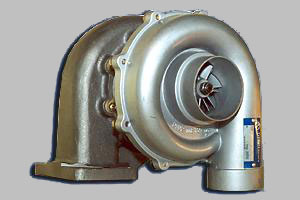
Turbochargers made in Russia and the CIS countries have the designation - TKR. There are several types that are different in size and performance, as well as the efficiency of 43 to 77%. They are used on diesel engines of various capacities, serial application on petrol engines turbine data is not yet available.
Is it possible to use turbine turbocharger on petrol engines?
Yes it is possible.
Do not burn the turbine blades, designed for diesel engines, the gasoline engine, because the temperature of combustion of diesel is higher than gasoline?
Cases of combustion turbine blades from diesel to petrol engine in practice were found. Temperature of the exhaust gases primarily given to the pistons, valves, cylinder block, exhaust manifold, and only then - the turbine.
Turbochargers Garrett.
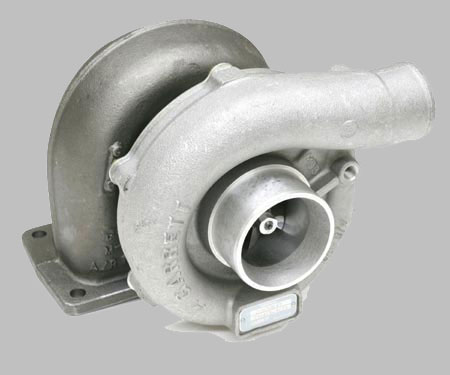 Widespread in use on production of diesel and petrol engines have turbine Garrett , which are produced at 14 plants around the world. They are also widely used in motorsports and tuning. There Garrett turbine not only with plain bearings (bronze bushings) as the TKR but with ball bearings that are marked with the letter "R", e.g. GT42R . Ball bearings are less sensitive to oil starvation, high turnover, have less friction, and therefore faster to spin. Also, there are a conduit for the turbine bearing cooling using a liquid coolant, which is beneficial to their service life.
Widespread in use on production of diesel and petrol engines have turbine Garrett , which are produced at 14 plants around the world. They are also widely used in motorsports and tuning. There Garrett turbine not only with plain bearings (bronze bushings) as the TKR but with ball bearings that are marked with the letter "R", e.g. GT42R . Ball bearings are less sensitive to oil starvation, high turnover, have less friction, and therefore faster to spin. Also, there are a conduit for the turbine bearing cooling using a liquid coolant, which is beneficial to their service life.
Air flow turbochargers and boost the rate of increase.
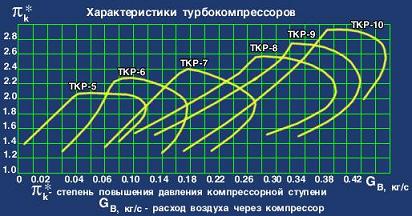
Each turbocharger has a capacity of pumping air. Maximum boost pressure is obtained at the optimum speed of the rotor, which do not exceed the costs, or suffer bearing turbine. The diagram shows the performance of turbine turbocharger.
For example turbine TKR-6 , which is used on machines such as "Bychock ZIL" and "Valdai GAZ", will show maximum 130 bhp on the diesel engine, and 250 bhp on gasoline.
At the TKR-6 compressor wheel diameter 60 mm, and TKR-10 100 mm, respectively, is evident from the labeling turbines.
TKR is designed for high volume engines, so it makes sense when applied to low-volume gasoline engines is a hybrid, that is, take a hot piece of a smaller turbine for an earlier promotion of the turbine shaft (spool).
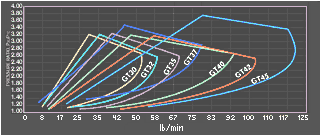 This figure represented the airflow turbines Garrett in lbs/min and pressure ratio.
Airflow 10 pounds per minute is approximately 100 bhp final engine output.
This figure represented the airflow turbines Garrett in lbs/min and pressure ratio.
Airflow 10 pounds per minute is approximately 100 bhp final engine output.
Pressure ratio on the maps (absolute pressure) is always one more than the over-pressure gauge that shows in the inlet.
Turbocharger for tuning is to choose the size of the turbine and compressor parts. With smaller turbine (hot) part, the earlier start charging system on the engine. But the little hot part on certain speeds will "plug up" the engine. For serial and city cars is quite acceptable.
The same can be said of the compressor part, the smaller the engine before the inlet plugs, and outputs a relatively small pressure boost.
But the best part of the compressor is designed for high boost and power of the engine, so the city does not use machines. Just a big compressor wheel is surging on low-volume engines.
Wastegate valve.
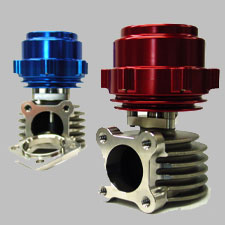 Wastegate bypass valve is used to protect the bearing and turbine engine of destruction. Exhaust gas flow trying to unwind impeller to infinity, thereby pumping more and more air to the engine. Accordingly, the air increases the amount of the working mixture, increasing the flow of exhaust gases. The turbine spins faster. It is a vicious cycle.
Wastegate bypass valve is used to protect the bearing and turbine engine of destruction. Exhaust gas flow trying to unwind impeller to infinity, thereby pumping more and more air to the engine. Accordingly, the air increases the amount of the working mixture, increasing the flow of exhaust gases. The turbine spins faster. It is a vicious cycle.
If this cycle does not stop, the turbine is gaining momentum much greater than the maximum 100000-150000 rpm, giving a big boost pressure. If the engine is not designed for this kind of pressure, detonation, and fast failure of the pistons. Also, high speed turbine cause surging, when it is not already the air into the engine and back to the inlet of the compressor with the corresponding sound.
The bypass valve is of two types: built-in and external. Built-in (actuator) is attached directly to the turbine, and has a flap that diverts part of the exhaust gas at a certain pressure, bypassing the turbine in the exhaust system. He has a limited capacity, it can not take too much of the flow of exhaust gases.
Outer valve performs the same function, but is attached to the exhaust manifold. When the set pressure compressor opens and starts to play off the exhaust gases from the exhaust manifold, bypassing the turbine - the muffler, not allowing the turbine to spin up more than fixed.
Blow-Off valve.
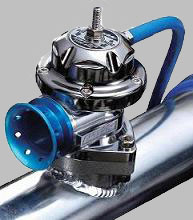 It is also called - bypass valve. Blow-off clears the air on the street (with a corresponding sound), and the bypass back into the turbine is usually applied with MAF-sensor. Unlike this wastegate valve does not open the pressure turbocharger and of a vacuum which is created in the intake throttle valve when closed. The valve blow-off is placed on the inlet pipe between the compressor and the throttle. A vacuum is taken at the same place and on the brakes in the intake manifold. It is also called - bypass valve. Blow-off clears the air on the street (with a corresponding sound), and the bypass back into the turbine is usually applied with MAF-sensor. Unlike this wastegate valve does not open the pressure turbocharger and of a vacuum which is created in the intake throttle valve when closed. The valve blow-off is placed on the inlet pipe between the compressor and the throttle. A vacuum is taken at the same place and on the brakes in the intake manifold.
Imagine the situation: you are overclocking engine, turbine, gaining full speed, the air pressure in the inlet of 2.5 bars, the flow of air at high speed enters the engine, and ... you throw a gas that would change gear. The throttle is closed but the turbine is spinning at the same speed. Oops ... it seems it was a kick air (surge). Compressor blades at this point not to be envied. Typically frequent surging oppression compressor shaft, blade thrust bearing wears out.
You switched the speed, and turbine blades have reduced their rotation, and the need to promote them again, and this is a waste of time.
In order to be at the closing of the throttle, the air has found its way, and there is a valve blow-off. Vacuum formed at the close of the throttle instantly opens the bypass valve, and air flow without hindrance comes out, or the input of the turbocharger. Impeller turbine does not lose its momentum and is ready to unfold again at a new gear.
Intercooler.
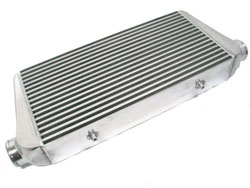 Intercooler is an integral part of the engine with a turbocharger. It works much like a radiator in a car, not only cools the antifreeze, and the air is heated by the turbine. The turbocharger has two parts - the hot and cold. Hottest part of the exhaust gases is unwound, and extremely hot. The cool part is pumping air into the engine, thus too much heat from the hot side.
Intercooler is an integral part of the engine with a turbocharger. It works much like a radiator in a car, not only cools the antifreeze, and the air is heated by the turbine. The turbocharger has two parts - the hot and cold. Hottest part of the exhaust gases is unwound, and extremely hot. The cool part is pumping air into the engine, thus too much heat from the hot side.
Hot air is much enlarged, and there are fewer oxygen molecules, so the desired engine. Therefore, the air must be cooled, otherwise the whole effect of turbo does not make sense. The cooler air entering the engine, the greater its capacity.
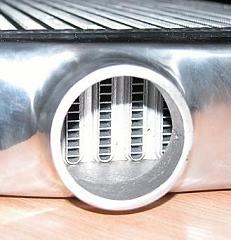 Size of the intercooler also can not be increased indefinitely, the larger intercooler, the more turboproval that is pumped air is lost in the depths of the intercooler is too big for a raise accelerator. But on powerful motors must be large enough, otherwise the small intercooler will slow the flow of air from the large turbocharger. For example, the motor capacity of 1000 bhp inlet and outlet of the intercooler must be at least 100 mm.
Size of the intercooler also can not be increased indefinitely, the larger intercooler, the more turboproval that is pumped air is lost in the depths of the intercooler is too big for a raise accelerator. But on powerful motors must be large enough, otherwise the small intercooler will slow the flow of air from the large turbocharger. For example, the motor capacity of 1000 bhp inlet and outlet of the intercooler must be at least 100 mm.
Intercooler is a little different in structure from the radiator antifreeze. It channels exist more partitions to air gave heat as quickly as possible. Also it withstands high temperature and pressure, and is made entirely of metal (aluminum) for greater strength.
Small but precious.
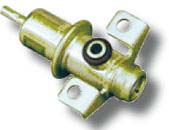 The fuel pressure regulator (FPR) is applied to the injection engines to maintain a constant fuel pressure in the fuel rail, which supplies the nozzle. Typically, the fuel pressure is 3 bar, and this figure is calculated performance injectors all manufacturers. On new engines Lada VAZ 1.6 liter (380 FPR) the fuel pressure is increased to 3.8 bar.
The fuel pressure regulator (FPR) is applied to the injection engines to maintain a constant fuel pressure in the fuel rail, which supplies the nozzle. Typically, the fuel pressure is 3 bar, and this figure is calculated performance injectors all manufacturers. On new engines Lada VAZ 1.6 liter (380 FPR) the fuel pressure is increased to 3.8 bar.
But FPR 300 is another useful feature - it adjusts the fuel pressure, depending on the pressure in the intake manifold. To do this, the regulator is suitable rubber hose. At atmospheric engines at closing the throttle manifold vacuum is created, and therefore fuel begins to flow into the engine harder. The opposite effect occurs on turbocharged engines: Intake manifold pressure produce large, and the fuel flows from the nozzles in smaller quantities than calculates. It turns out that the performance of nozzles is calculated at atmospheric pressure. But the regulator with the function of adjusting the fuel pressure helps to cope with this task.
Recommended adjustment of fuel pressure - 1-1 to change the air pressure.
For reference an increase in fuel pressure at 100% capacity nozzles increases by 50%.
Oil cooler.
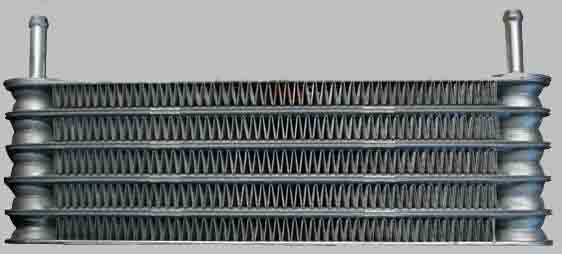
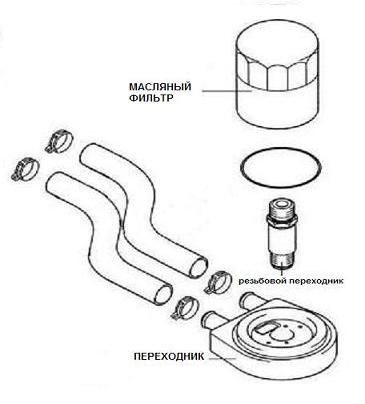 On turbocharged engines greatly increases the thermal regime of the engine. The number of working mixture burned per unit of time increases in proportion to boost pressure, heat is transferred accordingly, not only in engine size, but also transferred its parts. Heat up the pistons, cylinders, exhaust system and the turbine.
On turbocharged engines greatly increases the thermal regime of the engine. The number of working mixture burned per unit of time increases in proportion to boost pressure, heat is transferred accordingly, not only in engine size, but also transferred its parts. Heat up the pistons, cylinders, exhaust system and the turbine.
At a temperature of 260 °C mineral components in the oil are charred, and settle in the oil ducts and bearing turbocharger. The same oil at high heat is very liquid and loses lubricating properties. Synthetic oil is less affected by heat, almost does not lose strength and coke, therefore it is preferable for the engines.
To avoid overheating of the oil, for this is the oil cooler. It is connected to a special adapter under the oil filter. Most turbines have a channel for the coolant (antifreeze) and therefore the only way to cool the turbine bearing - cold lubrication oil.
For the removal of excessive temperature of the turbo engine all good, and therefore it is desirable to have an oil cooler on each turbo car.
 Example of setting a turbocharger on a car VAZ capacity of more than 500 bhp >>> Example of setting a turbocharger on a car VAZ capacity of more than 500 bhp >>>
 Motors Formula 1 Turbo Era >>> Motors Formula 1 Turbo Era >>>
|